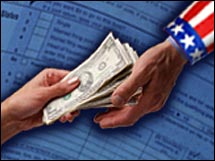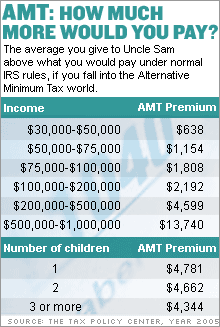 |
| With the Alternative Minimum Tax, you'll fork over even more come tax time. |
|
 |
|
|
|
|
NEW YORK (CNN/Money) -
Maybe you've managed to ignore the recent spate of tax-reform stories, but that doesn't mean you'll dodge the Alternative Minimum Tax or its higher tax bite.
The AMT system comes with a completely different set of rates and deduction rules. People pay it only if their AMT tax amount is higher than their traditional taxes. Translation: if you're paying the AMT, you are by definition paying higher taxes.
The system created to make sure the uber-rich didn't dodge the tax bullet is under fire because it's now affecting middle-class Americans. And reforming it could mean increased tax payments for everyone.
The problem? What defined uber-rich in 1969, when the AMT was first enacted, has never been adjusted for inflation. That means what made you affluent back then doesn't now -- but you're still taxed like it does.
The Urban-Brookings Tax Policy Center says the AMT will hit 3.6 million out of the nation's 131 million taxpayers filing for tax year 2005 (filed in early 2006), and could affect 31 million by 2010 if nothing is done.
To give you a sense of just who might get caught, this year only 1.8 percent of married couples with two kids and an adjusted gross income between $75,000 and $100,000 will be subject to AMT. Next year, that number jumps to 73.4 percent.
A tale of two systems
Under the regular IRS rules, you start with your gross income and subtract deductions like state taxes you paid, and exemptions like child credits. Eventually, you arrive at your taxable income.
Under AMT rules, you still start with your gross income, but many of the usual deductions and exemptions are disallowed. Suddenly, your taxable income is a lot higher.
Even though some deductions still stand, including those for mortgage-interest and charitable donations, some key breaks are lost. They include:
- state and local income taxes and property taxes
- unreimbursed business expenses
- child-tax credits
- tax-preparation fees
- legal fees
- home-equity loan interest
Even though the highest tax rate under the AMT -- 28 percent -- is lower than that in the regular tax system -- 35 percent -- AMT victims are paying more because they're paying on a greater amount of taxable income.
Short of moving to a low-tax state like, say, Texas, said Len Burman, co-director of the Tax Policy Center, there's not a lot you can do to avoid AMT's clutches.
Exemptions and phase-outs
In trying to determine tax liability under AMT, you do get to exempt a certain amount of income from your calculations.
The problem is that the exemptions granted under the AMT have not kept pace with inflation -- while the average paycheck has. For instance, in 1982, the exemption for married couples filing joint was $40,000. Adjusted for inflation, that would be $82,000 today.
Currently, the exemptions are only $58,000 for married couples filing jointly and $40,250 for singles. And they would be even lower if Congress every year did not vote through a "patch."
Really high earners may not even get the full exemption since it is phased out above certain income levels.
The phase-out for married couples filing jointly begins at $150,000 (after the deductions that are allowable). The deduction shrinks by 25 cents for every dollar earned above that amount until finally, at $382,000, there is no exemption at all.
Who gets burned?
By law, everyone who files taxes is obligated to figure out whether they have to pay AMT, and they are prompted to do so on line 44 of Form 1040.
There, taxpayers are referred to the AMT worksheet. If the taxable income on the worksheet is higher than the taxable income on the 1040, you are subject to AMT and must fill out the special AMT Form 6251.
But the 12-line worksheet and Form 6251 can be daunting, and 75 percent of AMT payers hire a professional to do their returns, according to the President's Advisory Panel on Federal Tax Reform.
"The first time most people hear about the Alternative Minimum Tax is when they get a letter from the IRS saying that they still owe money," said the Tax Policy Center's Burman.
So how do you know if you'll be one of the unlucky?
If your total deductions and exemptions under the normal tax code come close to the AMT exemption, you want to be on the lookout for the AMT, said Tom Ochsenschlager, vice president of taxation with the American Institute of Certified Public Accountants.
Also be on the lookout if your adjusted gross income changes dramatically because of:
- a lot of itemized deductions
- high local and state tax deductions
- child exemptions
- a mortgage deduction
Then it may be time to get some professional help or some good tax software.
----------------------
Click here for top 5 year-end tax tips.
The president's Tax Reform Panel wants AMT dead. Click here for more.

|